 During whole group time, students sit on the floor in three semi-circular rows. Spots are designated with students’ names on masking tape.
During whole group time, students sit on the floor in three semi-circular rows. Spots are designated with students’ names on masking tape.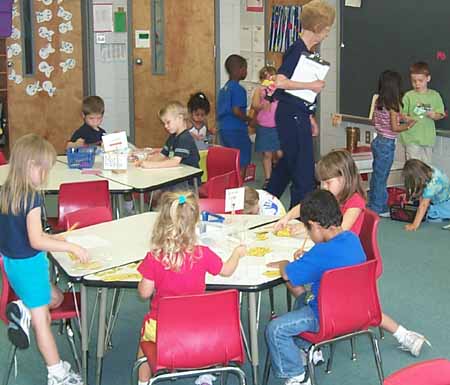 Students working in the science (front table), math (back table), ABC (floor and chalkboard), and drama (standing in front of curtain) centers. Rachel Faggart, Erin’s assistant, monitors students and takes anecdotal notes.
Students working in the science (front table), math (back table), ABC (floor and chalkboard), and drama (standing in front of curtain) centers. Rachel Faggart, Erin’s assistant, monitors students and takes anecdotal notes.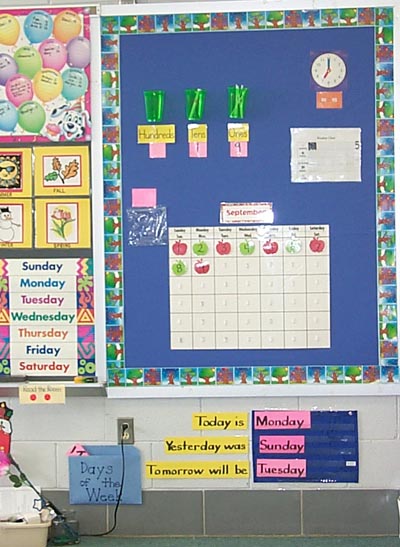 Erin uses a bulletin board and part of her chalkboard at the front of the room for a calendar. A tub containing calendar supplies can be seen on the floor in the lower left.
Erin uses a bulletin board and part of her chalkboard at the front of the room for a calendar. A tub containing calendar supplies can be seen on the floor in the lower left. 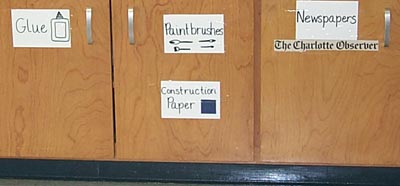 Labels with words and pictures on the outside of cabinet doors allow students to easily access materials.
Labels with words and pictures on the outside of cabinet doors allow students to easily access materials.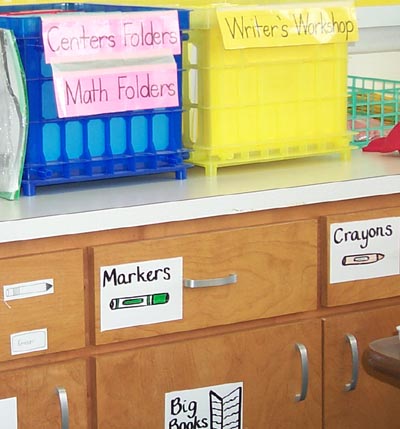 Labeled file crates located on the counter next to the assistant’s desk contain student work. More examples of labels for student supplies can be seen.
Labeled file crates located on the counter next to the assistant’s desk contain student work. More examples of labels for student supplies can be seen. In addition to displaying the day’s helpers, cabinets above the sink label classroom supplies so that Erin can access them quickly and easily.
In addition to displaying the day’s helpers, cabinets above the sink label classroom supplies so that Erin can access them quickly and easily.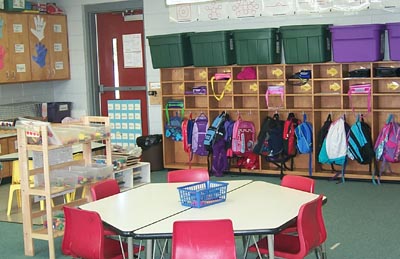 Shelves and hooks along one wall provide space for students lunches, bookbags and coats. Erin keeps unit and math tub materials that are not currently being used in large tubs on top of the shelving. Hanging folders on wire frames in the tubs help keep materials neat and organized. The shelves in the middle of the floor are used for math tubs and storage. During center time, the pictured table is the math center.
Shelves and hooks along one wall provide space for students lunches, bookbags and coats. Erin keeps unit and math tub materials that are not currently being used in large tubs on top of the shelving. Hanging folders on wire frames in the tubs help keep materials neat and organized. The shelves in the middle of the floor are used for math tubs and storage. During center time, the pictured table is the math center.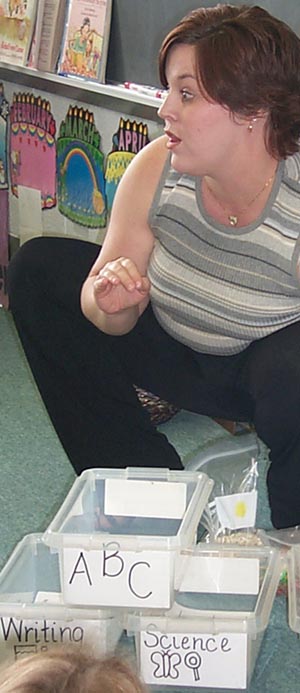 Before beginning center time, Erin reviews and explains activities in centers. Labeled tubs containing materials are placed in the center areas.
Before beginning center time, Erin reviews and explains activities in centers. Labeled tubs containing materials are placed in the center areas. At the end of center time, students color in the centers they completed that day. At the beginning of the week, Erin draws stars next to centers that must be completed by the end of the week.
At the end of center time, students color in the centers they completed that day. At the beginning of the week, Erin draws stars next to centers that must be completed by the end of the week.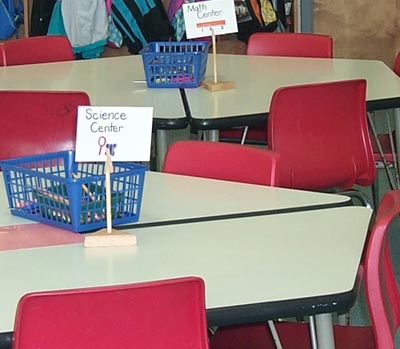 Portable signs are placed at center areas for labeling. Pictures on the signs match pictures on students’ center sheets.
Portable signs are placed at center areas for labeling. Pictures on the signs match pictures on students’ center sheets.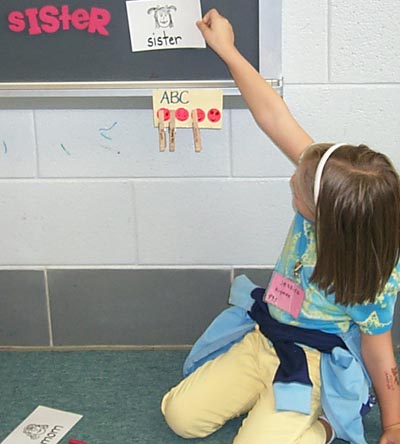 A student checks her work at the ABC center. Cards with words and pictures that coordinate with the class theme are located at the center. The sentence strip at the base of the chalkboard designates the maximum number of students who may work in the center at a time. Students place clips with their name on them onto the label when entering a center.
A student checks her work at the ABC center. Cards with words and pictures that coordinate with the class theme are located at the center. The sentence strip at the base of the chalkboard designates the maximum number of students who may work in the center at a time. Students place clips with their name on them onto the label when entering a center. 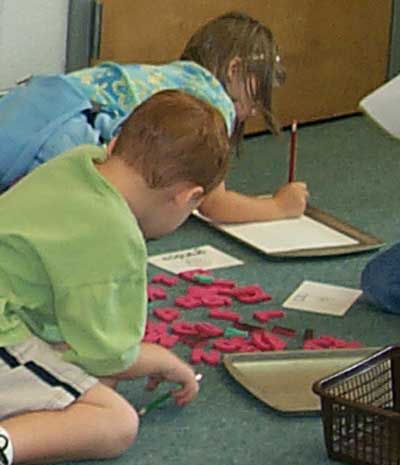 Students work on the floor to create and record words at the ABC center. Cookie sheets provide an additional magnetic surface.
Students work on the floor to create and record words at the ABC center. Cookie sheets provide an additional magnetic surface.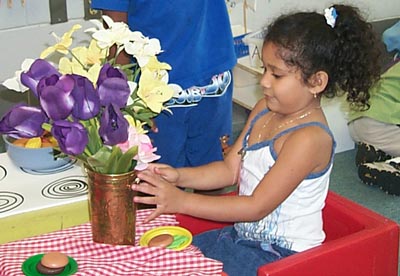 Students create a “meal” in the drama center. Four large plastic cubes can be used as tables or chairs in the center. Erin created a “stove” on one of the cubes with contact paper and magic marker.
Students create a “meal” in the drama center. Four large plastic cubes can be used as tables or chairs in the center. Erin created a “stove” on one of the cubes with contact paper and magic marker.  When the center is not in use, the large cubes used as furniture for the drama center are stacked against the ABC shelves. Materials for the center — clothing, food, cooking supplies — are placed inside the stacked cubes.
When the center is not in use, the large cubes used as furniture for the drama center are stacked against the ABC shelves. Materials for the center — clothing, food, cooking supplies — are placed inside the stacked cubes. A quiet corner of the room behind Rachel’s desk holds the reading center. Books are organized in baskets on the shelves. Leveled books for Erin to use for guided reading groups are located in plastic bags in baskets on top of the shelves.
A quiet corner of the room behind Rachel’s desk holds the reading center. Books are organized in baskets on the shelves. Leveled books for Erin to use for guided reading groups are located in plastic bags in baskets on top of the shelves.  Construction paper matching the shape and color of the baskets for writing supplies designate spaces for materials.
Construction paper matching the shape and color of the baskets for writing supplies designate spaces for materials.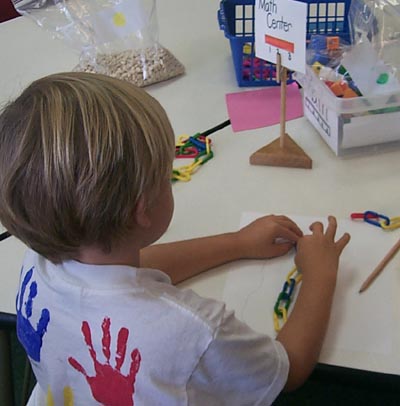 A student at the math center measures the outline of his foot. The difficulty of this center is increased for some students who use the smaller beans in the bag with the yellow dot on it to measure the outlines of their hand and foot.
A student at the math center measures the outline of his foot. The difficulty of this center is increased for some students who use the smaller beans in the bag with the yellow dot on it to measure the outlines of their hand and foot.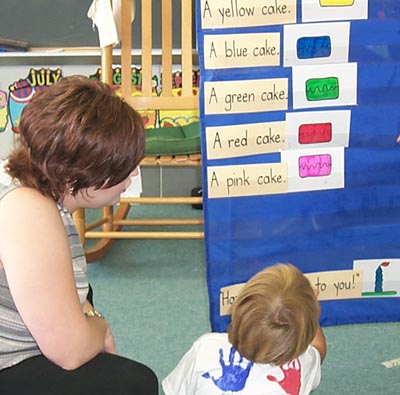 Erin listens to a student read the pocketchart after he’s arranged the words and the pictures.
Erin listens to a student read the pocketchart after he’s arranged the words and the pictures.
 During whole group time, students sit on the floor in three semi-circular rows. Spots are designated with students’ names on masking tape.
During whole group time, students sit on the floor in three semi-circular rows. Spots are designated with students’ names on masking tape. Students working in the science (front table), math (back table), ABC (floor and chalkboard), and drama (standing in front of curtain) centers. Rachel Faggart, Erin’s assistant, monitors students and takes anecdotal notes.
Students working in the science (front table), math (back table), ABC (floor and chalkboard), and drama (standing in front of curtain) centers. Rachel Faggart, Erin’s assistant, monitors students and takes anecdotal notes. Erin uses a bulletin board and part of her chalkboard at the front of the room for a calendar. A tub containing calendar supplies can be seen on the floor in the lower left.
Erin uses a bulletin board and part of her chalkboard at the front of the room for a calendar. A tub containing calendar supplies can be seen on the floor in the lower left.  Labels with words and pictures on the outside of cabinet doors allow students to easily access materials.
Labels with words and pictures on the outside of cabinet doors allow students to easily access materials. Labeled file crates located on the counter next to the assistant’s desk contain student work. More examples of labels for student supplies can be seen.
Labeled file crates located on the counter next to the assistant’s desk contain student work. More examples of labels for student supplies can be seen. In addition to displaying the day’s helpers, cabinets above the sink label classroom supplies so that Erin can access them quickly and easily.
In addition to displaying the day’s helpers, cabinets above the sink label classroom supplies so that Erin can access them quickly and easily. Shelves and hooks along one wall provide space for students lunches, bookbags and coats. Erin keeps unit and math tub materials that are not currently being used in large tubs on top of the shelving. Hanging folders on wire frames in the tubs help keep materials neat and organized. The shelves in the middle of the floor are used for math tubs and storage. During center time, the pictured table is the math center.
Shelves and hooks along one wall provide space for students lunches, bookbags and coats. Erin keeps unit and math tub materials that are not currently being used in large tubs on top of the shelving. Hanging folders on wire frames in the tubs help keep materials neat and organized. The shelves in the middle of the floor are used for math tubs and storage. During center time, the pictured table is the math center. Before beginning center time, Erin reviews and explains activities in centers. Labeled tubs containing materials are placed in the center areas.
Before beginning center time, Erin reviews and explains activities in centers. Labeled tubs containing materials are placed in the center areas. At the end of center time, students color in the centers they completed that day. At the beginning of the week, Erin draws stars next to centers that must be completed by the end of the week.
At the end of center time, students color in the centers they completed that day. At the beginning of the week, Erin draws stars next to centers that must be completed by the end of the week. Portable signs are placed at center areas for labeling. Pictures on the signs match pictures on students’ center sheets.
Portable signs are placed at center areas for labeling. Pictures on the signs match pictures on students’ center sheets. A student checks her work at the ABC center. Cards with words and pictures that coordinate with the class theme are located at the center. The sentence strip at the base of the chalkboard designates the maximum number of students who may work in the center at a time. Students place clips with their name on them onto the label when entering a center.
A student checks her work at the ABC center. Cards with words and pictures that coordinate with the class theme are located at the center. The sentence strip at the base of the chalkboard designates the maximum number of students who may work in the center at a time. Students place clips with their name on them onto the label when entering a center.  Students work on the floor to create and record words at the ABC center. Cookie sheets provide an additional magnetic surface.
Students work on the floor to create and record words at the ABC center. Cookie sheets provide an additional magnetic surface. Students create a “meal” in the drama center. Four large plastic cubes can be used as tables or chairs in the center. Erin created a “stove” on one of the cubes with contact paper and magic marker.
Students create a “meal” in the drama center. Four large plastic cubes can be used as tables or chairs in the center. Erin created a “stove” on one of the cubes with contact paper and magic marker.  When the center is not in use, the large cubes used as furniture for the drama center are stacked against the ABC shelves. Materials for the center — clothing, food, cooking supplies — are placed inside the stacked cubes.
When the center is not in use, the large cubes used as furniture for the drama center are stacked against the ABC shelves. Materials for the center — clothing, food, cooking supplies — are placed inside the stacked cubes. A quiet corner of the room behind Rachel’s desk holds the reading center. Books are organized in baskets on the shelves. Leveled books for Erin to use for guided reading groups are located in plastic bags in baskets on top of the shelves.
A quiet corner of the room behind Rachel’s desk holds the reading center. Books are organized in baskets on the shelves. Leveled books for Erin to use for guided reading groups are located in plastic bags in baskets on top of the shelves.  Construction paper matching the shape and color of the baskets for writing supplies designate spaces for materials.
Construction paper matching the shape and color of the baskets for writing supplies designate spaces for materials. A student at the math center measures the outline of his foot. The difficulty of this center is increased for some students who use the smaller beans in the bag with the yellow dot on it to measure the outlines of their hand and foot.
A student at the math center measures the outline of his foot. The difficulty of this center is increased for some students who use the smaller beans in the bag with the yellow dot on it to measure the outlines of their hand and foot. Erin listens to a student read the pocketchart after he’s arranged the words and the pictures.
Erin listens to a student read the pocketchart after he’s arranged the words and the pictures.